On the Performance of Diffuse Ceiling Ventilation in Classrooms: A Pre-Occupancy Study at a School in Southern Sweden
Abstract
1. Introduction
2. Materials and Methods
2.1. Classrooms and System Description
2.2. Measurements
2.2.1. Room Air Speed and Temperature
2.2.2. Thermal Comfort Assessment
2.2.3. Ventilation Efficiency Measurement
- Local air change index which is the measure of how fast supplied-air reaches a specified point and replaces the old air in the room [27]. This is expressed as
- b.
- Air change efficiency: this is the measure of how efficiently the supply air is distributed and the room and it is defined by the expression:
2.2.4. Acoustic Measurements
3. Results and Discussions
3.1. Temperature Distribution
3.2. Air Speed Distribution
3.3. Local Heat Removal Efficiency (LHRE)
3.4. Thermal Comfort Prediction
3.5. Ventilation Efficiency
3.6. Room Acoustics
4. Conclusions
Author Contributions
Funding
Institutional Review Board Statement
Informed Consent Statement
Data Availability Statement
Conflicts of Interest
References
- Gamarra, A.R.; Istrate, I.R.; Herrera, I.; Lago, C.; Lizana, J.; Lechón, Y. Energy and water consumption and carbon footprint of school buildings in hot climate conditions. Results from life cycle assessment. J. Clean. Prod. 2018, 195, 1326–1337. [Google Scholar] [CrossRef]
- Zhan, J.; Liu, W.; Wu, F.; Li, Z.; Wang, C. Life cycle energy consumption and greenhouse gas emissions of urban residential buildings in Guangzhou city. J. Clean. Prod. 2018, 194, 318–326. [Google Scholar] [CrossRef]
- Wu, W.; Yoon, N.; Tong, Z.; Chen, Y.; Lv, Y.; Ærenlund, T.; Benner, J. Diffuse ceiling ventilation for buildings: A review of fundamental theories and research methodologies. J. Clean. Prod. 2019, 211, 1600–1619. [Google Scholar] [CrossRef]
- Pérez-Lombard, L.; Ortiz, J.; Pout, C. A review on buildings energy consumption information. Energy Build. 2008, 40, 394–398. [Google Scholar] [CrossRef]
- Wouters, P.; Delmotte, C. Ventilation, good indoor air quality and rational use of energy. Pollution Atmospherique. 2005. Available online: https://www.umad.de/infos/cleanair13/pdf/full_474.pdf (accessed on 17 January 2023).
- SeppĘnen, O. Ventilation strategies for good indoor air quality and energy efficiency. Int. J. Vent. 2008, 6, 297–306. [Google Scholar]
- Gao, X.; Li, Y.; Leung, G.M. Ventilation control of indoor transmission of airborne diseases in an Urban community. Indoor Built Environ. 2009, 18, 205–218. [Google Scholar] [CrossRef]
- Sandberg, M. The Dual Role of an Air Distribution System, Both Reducing the Concentration of Infectious Agents and Spreading Infectious Agents. Front. Built Environ. 2022, 7, 728968. [Google Scholar] [CrossRef]
- Sandberg, M.; Kabanshi, A.; Wigö, H. Is building ventilation a process of diluting contaminants or delivering clean air? Indoor Built Environ. 2020, 29, 768–774. [Google Scholar] [CrossRef]
- Agarwal, N.; Meena, C.S.; Raj, B.P.; Saini, L.; Kumar, A.; Gopalakrishnan, N.; Kumar, A.; Balam, N.B.; Alam, T.; Kapoor, N.R.; et al. Indoor air quality improvement in COVID-19 pandemic: Review. Sustain. Cities Soc. 2021, 70, 102942. [Google Scholar] [CrossRef]
- Balaban, O.; Puppim de Oliveira, J.A. Sustainable buildings for healthier cities: Assessing the co-benefits of green buildings in Japan. J. Clean. Prod. 2017, 163, S68–S78. [Google Scholar] [CrossRef]
- Jain, N.; Burman, E.; Robertson, C.; Stamp, S.; Shrubsole, C.; Aletta, F.; Barrett, E.; Oberman, T.; Kang, J.; Raynham, P.; et al. Building performance evaluation: Balancing energy and indoor environmental quality in a UK school building. Build. Serv. Eng. Res. Technol. 2020, 41, 343–360. [Google Scholar] [CrossRef]
- Montazami, A.; Nicol, F. Overheating in schools: Comparing existing and new guidelines. In Building Research and Information; Taylor & Francis: New York, NY, USA, 2013; Volume 41. [Google Scholar]
- Grassie, D.; Schwartz, Y.; Symonds, P.; Korolija, I.; Mavrogianni, A.; Mumovic, D. Energy retrofit and passive cooling: Overheating and air quality in primary schools. Build. Cities 2022, 3, 204–225. [Google Scholar] [CrossRef]
- Teli, D.; Dalenback, J.-O.; Ekberg, L. Winter thermal comfort and indoor air quality in Swedish grade school classrooms, as assessed by the children. In Proceedings of the 14th International Conference of Indoor Air Quality and Climate, Ghent, Belgium, 3–8 July 2016. [Google Scholar]
- Bakó-Biró, Z.; Clements-Croome, D.J.; Kochhar, N.; Awbi, H.B.; Williams, M.J. Ventilation rates in schools and pupils’ performance. Build. Environ. 2012, 48, 215–223. [Google Scholar] [CrossRef]
- Mendell, M.J.; Eliseeva, E.A.; Davies, M.M.; Spears, M.; Lobscheid, A.; Fisk, W.J.; Apte, M.G. Association of classroom ventilation with reduced illness absence: A prospective study in California elementary schools. Indoor Air 2013, 23, 515–528. [Google Scholar] [CrossRef]
- Zhang, C.; Andersen, R.; Christodoulou, G.; Kubilius, M.; Heiselberg, P.K. An experimental investigation into the ventilation effectiveness of diffuse ceiling ventilation. In Proceedings of the 39th AIVC Conference, 7th TightVent Conference and 5th venticool Conference, Antibes, France, 18–19 September 2018. [Google Scholar]
- Yang, B.; Melikov, A.K.; Kabanshi, A.; Zhang, C.; Bauman, F.S.; Cao, G.; Awbi, H.; Wigö, H.; Niu, J.; Cheong, K.W.D.; et al. A review of advanced air distribution methods—Theory, practice, limitations and solutions. Energy Build. 2019, 202, 109359. [Google Scholar] [CrossRef]
- Amai, H.; Novoselac, A. Experimental study on air change effectiveness in mixing ventilation. Build. Environ. 2016, 109, 101–111. [Google Scholar] [CrossRef]
- Griefahn, B.; Künemund, C.; Gehring, U. Evaluation of draught in the workplace. Ergonomics 2002, 45, 124–135. [Google Scholar] [CrossRef]
- Fan, M.; Fu, Z.; Wang, J.; Wang, Z.; Suo, H.; Kong, X.; Li, H. A review of different ventilation modes on thermal comfort, air quality and virus spread control. Build. Environ. 2022, 212, 108831. [Google Scholar] [CrossRef]
- Sandberg, M. Ventilation Effectiveness and Purging Flow Rate—A Review. In International Symposium on Room Air Convection and Ventilation EHectiveness; Unillersity of Tokyo: Tokyo, Japan, 1992. [Google Scholar]
- Zhang, C.; Heiselberg, P.; Nielsen, P.V. Diffuse ceiling ventilation—A review. Int. J. Vent. 2014, 13, 49–63. [Google Scholar] [CrossRef]
- Larsson, U. On the Performance of Stratified Ventilation; Linköping University Electronic Press: Linköping, Sweden, 2018; pp. 1–88. Available online: https://www.diva-portal.org/smash/get/diva2:1235642/FULLTEXT01.pdf (accessed on 17 January 2023).
- Shi, Z.; Lu, Z.; Chen, Q. Indoor airflow and contaminant transport in a room with coupled displacement ventilation and passive-chilled-beam systems. Build. Environ. 2019, 161, 106244. [Google Scholar] [CrossRef]
- Kabanshi, A.; Wigö, H.; Sandberg, M. Experimental evaluation of an intermittent air supply system—Part 1: Thermal comfort and ventilation efficiency measurements. Build. Environ. 2016, 95, 240–250. [Google Scholar] [CrossRef]
- Jacobs, P.; Knoll, B. Diffuse ceiling ventilation for fresh classrooms. In Proceedings of the 4th International Symposium on Building and Ductwork Air Tightness, Berlin, Germany, 1–2 October 2009; Available online: https://www.aivc.org/sites/default/files/members_area/medias/pdf/Conf/2009/AIVC_Jacobs_fullpaper_engl.pdf (accessed on 29 January 2023).
- Zhang, C.; Heiselberg, P. Diffuse ceiling ventilation. REHVA J. 2019, 78–82. Available online: https://www.rehva.eu/rehva-journal/chapter/diffuse-ceiling-ventilation (accessed on 17 January 2023).
- Jacobs, P.; Van Oeffelen, E.C.M.; Knoll, B. Diffuse ceiling ventilation, a new concept for healthy and productive classrooms. Indoor Air 2008, 17–22. Available online: https://www.ageing.tno.nl/media/2900/indoor-air-2008.pdf (accessed on 17 January 2023).
- Nielsen, P.V.; Jakubowska, E. The Performance of Diffuse Ceiling Inlet and other Room Air Distribution Systems; Cold Climate HVAC: Sisimiut, Greenland, 2009. [Google Scholar]
- Zhang, C.; Kristensen, M.H.; Jensen, J.S.; Heiselberg, P.K.; Jensen, R.L.; Pomianowski, M. Parametrical analysis on the diffuse ceiling ventilation by experimental and numerical studies. Energy Build. 2016, 111, 87–97. [Google Scholar] [CrossRef]
- Nocente, A.; Arslan, T.; Grynning, S.; Goia, F. CFD study of diffuse ceiling ventilation through perforated ceiling panels. Energies 2020, 13, 1995. [Google Scholar] [CrossRef]
- Hviid, C.A.; Svendsen, S. Experimental study of perforated suspended ceilings as diffuse ventilation air inlets. Energy Build. 2013, 56, 160–168. [Google Scholar] [CrossRef]
- Nocente, A.; Arslan, T.; Grynning, S.; Goia, F. Effects of a ceiling diffuser on diffuse ceiling ventilation (DCV) performance. Build. Simul. Conf. Proc. 2019, 1, 593–599. [Google Scholar] [CrossRef]
- Yang, B.; Guo, Y.; Xu, S.; Su, W.; Wu, M.; Wang, F. Performance optimization of a sidewall radiant heating system integrated with diffuse ceiling ventilation. Build. Environ. 2022, 213, 108881. [Google Scholar] [CrossRef]
- Zhao, W.; Kilpeläinen, S.; Kosonen, R.; Jokisalo, J. Experimental comparison of local low velocity unit combined with radiant panel and diffuse ceiling ventilation systems. Indoor Built Environ. 2020, 29, 895–914. [Google Scholar] [CrossRef]
- Guo, R.; Heiselberg, P.; Hu, Y.; Johra, H.; Zhang, C.; Jensen, R.L.; Jønsson, K.T.; Peng, P. Experimental investigation of convective heat transfer for night cooling with diffuse ceiling ventilation. Build. Environ. 2021, 193, 107665. [Google Scholar] [CrossRef]
- Krusaa, M.R.; Hviid, C.A. Reduced-scale experiments of heat transfer from integrated radiant ceiling panel and diffuse ceiling ventilation. Appl. Therm. Eng. 2021, 197, 117348. [Google Scholar] [CrossRef]
- Sadeghian, P.; Rahnama, S.; Afshari, A.; Sadrizadeh, S. The role of design parameters on the performance of diffuse ceiling ventilation systems–thermal comfort analyses for indoor environment. Adv. Build. Energy Res. 2022, 16, 806–824. [Google Scholar] [CrossRef]
- Kabanshi, A.; Linden, E.; Ogbuagu, T.-C.C.; MacCutcheon, D.; Persson, T. Plenum airflow distribution and its influence on the performance of a diffuse ceiling ventilation. E3S Web Conf. 2022, 356, 01026. [Google Scholar] [CrossRef]
- ASHRAE-55; Thermal Environmental Conditions for Human Occupancy. ANSI/ASHRAE: Peachtree Corners, GA, USA, 2017; Volume 55. p. 7.
- INNOVA. Technical Documentation. In Medical Device Regulatory Practices; Jenny Stanford Publishing: New York, NY, USA, 2015; pp. 193–260. [Google Scholar] [CrossRef]
- ISO 7730; Ergonomics of the Thermal Environment Analytical Determination and Interpretation of Thermal Comfort Using Calculation of the PMV and PPD Indices and Local Thermal Comfort Criteria. International Organization for Standardization: Geneva, Switzerland, 2005; Volume 3.
- ASHRAE 55; Thermal Environmental Conditions for Human Occupancy. American Society of Heating, Refrigeration and Air-Conditioning Engineers: Atlanta, GA, USA, 2013.
- Kabanshi, A.; Wigö, H.; Van De Poll, M.K.; Ljung, R.; Sörqvist, P. The influence of heat, air jet cooling and noise on performance in classrooms. Int. J. Vent. 2015, 14, 321–332. [Google Scholar] [CrossRef]
- Irwin, D.R.; Simonson, C.J.; Saw, K.Y.; Besant, R.W. Contaminant and heat removal effectiveness and air-to-air heat/energy recovery for a contaminated air space. In Proceedings of the ASHRAE Transactions, Toronto, ON, Canada, 19–24 June 1998; Volume 104. [Google Scholar]
- Pereira, M.L.; Graudenz, G.; Tribess, A.; Morawska, L. Determination of particle concentration in the breathing zone for four different types of office ventilation systems. Build. Environ. 2009, 44, 904–911. [Google Scholar] [CrossRef]
- Ren, C.; Zhu, H.C.; Cao, S.J. Ventilation Strategies for Mitigation of Infection Disease Transmission in an Indoor Environment: A Case Study in Office. Buildings 2022, 12, 180. [Google Scholar] [CrossRef]
- Xu, C.; Luo, X.; Yu, C.; Cao, S.J. The 2019-nCoV epidemic control strategies and future challenges of building healthy smart cities. Indoor Built Environ. 2020, 29, 639–644. [Google Scholar] [CrossRef]
- Li, Y.; Leung, G.M.; Tang, J.W.; Yang, X.; Chao, C.Y.H.; Lin, J.Z.; Lu, J.W.; Nielsen, P.V.; Niu, J.; Qian, H.; et al. Role of ventilation in airborne transmission of infectious agents in the built environment—A multidisciplinary systematic review. Indoor Air 2007, 17, 2–18. [Google Scholar] [CrossRef]
- Li, Y.; Qian, H.; Hang, J.; Chen, X.; Cheng, P.; Ling, H.; Wang, S.; Liang, P.; Li, J.; Xiao, S.; et al. Probable airborne transmission of SARS-CoV-2 in a poorly ventilated restaurant. Build. Environ. 2021, 196, 107788. [Google Scholar] [CrossRef]
- Kuttruff, H. Room Acoustics; CRC Press: Boca Raton, FL, USA, 2018; ISBN 9781482266450. [Google Scholar]
- Moore, B.C.J. An Introduction to the Psychology of Hearing; BRILL: Leiden, The Netherlands, 2012. [Google Scholar]
- Serpilli, F.; Di Loreto, S.; Lori, V.; Di Perna, C. The impact of mechanical ventilation systems on acoustic quality in school environments. E3S Web Conf. 2022, 343, 05002. [Google Scholar] [CrossRef]
- The British Association of Teachers of the Deaf. Classroom Acoustics—Recommended Standards. 2001. Available online: //www.batod.org.uk/wp-content/uploads/2018/08/acoustic-standards.pdf (accessed on 17 January 2023).
- Cooke, M.; Garcia Lecumberri, M.L.; Barker, J. The foreign language cocktail party problem: Energetic and informational masking effects in non-native speech perception. J. Acoust. Soc. Am. 2008, 123, 414–427. [Google Scholar] [CrossRef] [PubMed]
- Leibold, L.J.; Hillock-Dunn, A.; Duncan, N.; Roush, P.A.; Buss, E. Influence of hearing loss on children’s identification of spondee words in a speech-shaped noise or a two-talker masker. Ear Hear. 2013, 34, 575–584. [Google Scholar] [CrossRef] [PubMed]
- Talarico, M.; Abdilla, G.; Aliferis, M.; Balazic, I.; Giaprakis, I.; Stefanakis, T.; Foenander, K.; Grayden, D.B.; Paolini, A.G. Effect of age and cognition on childhood speech in noise perception abilities. Audiol. Neurotol. 2006, 12, 13–19. [Google Scholar] [CrossRef] [PubMed]
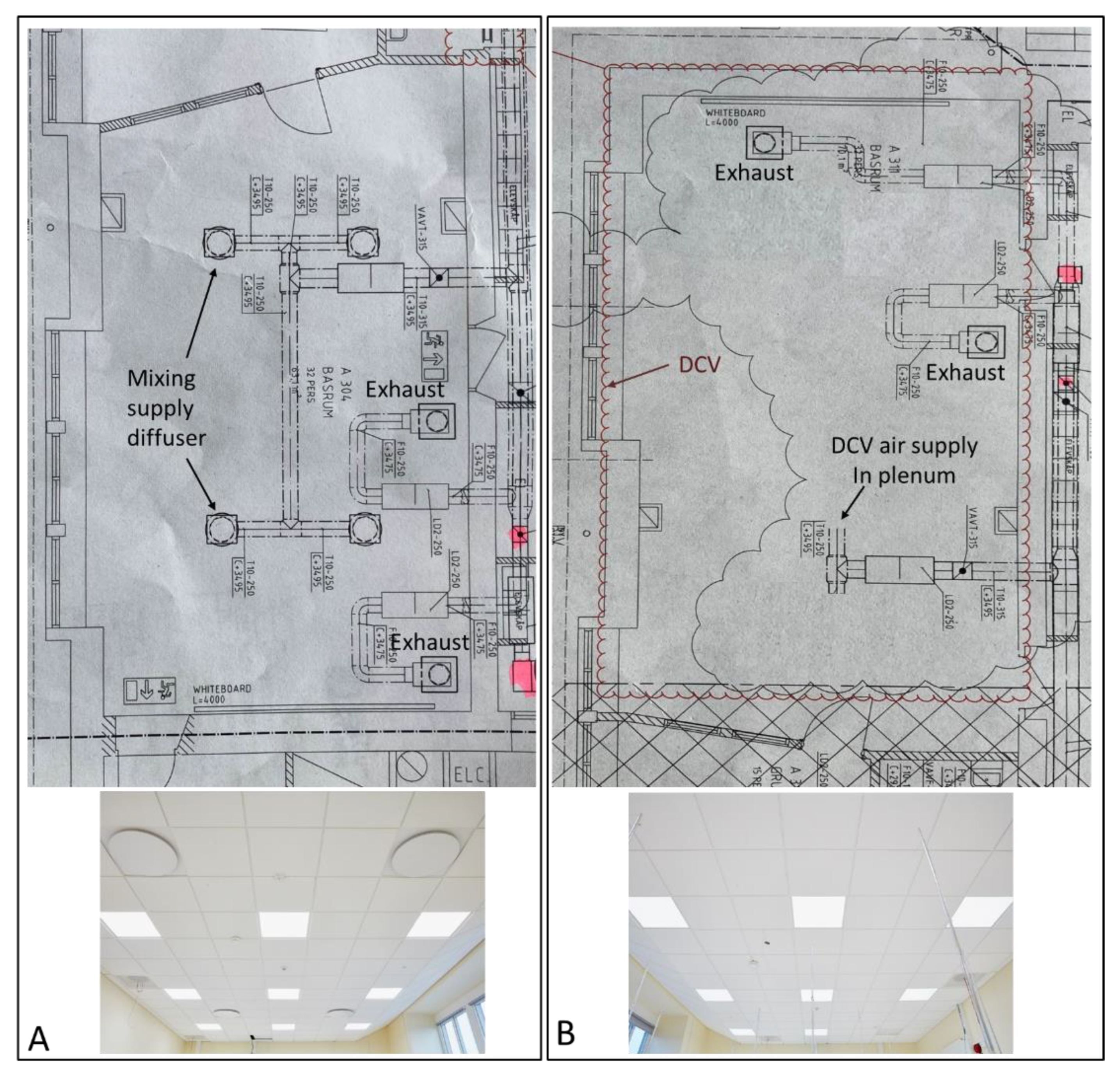

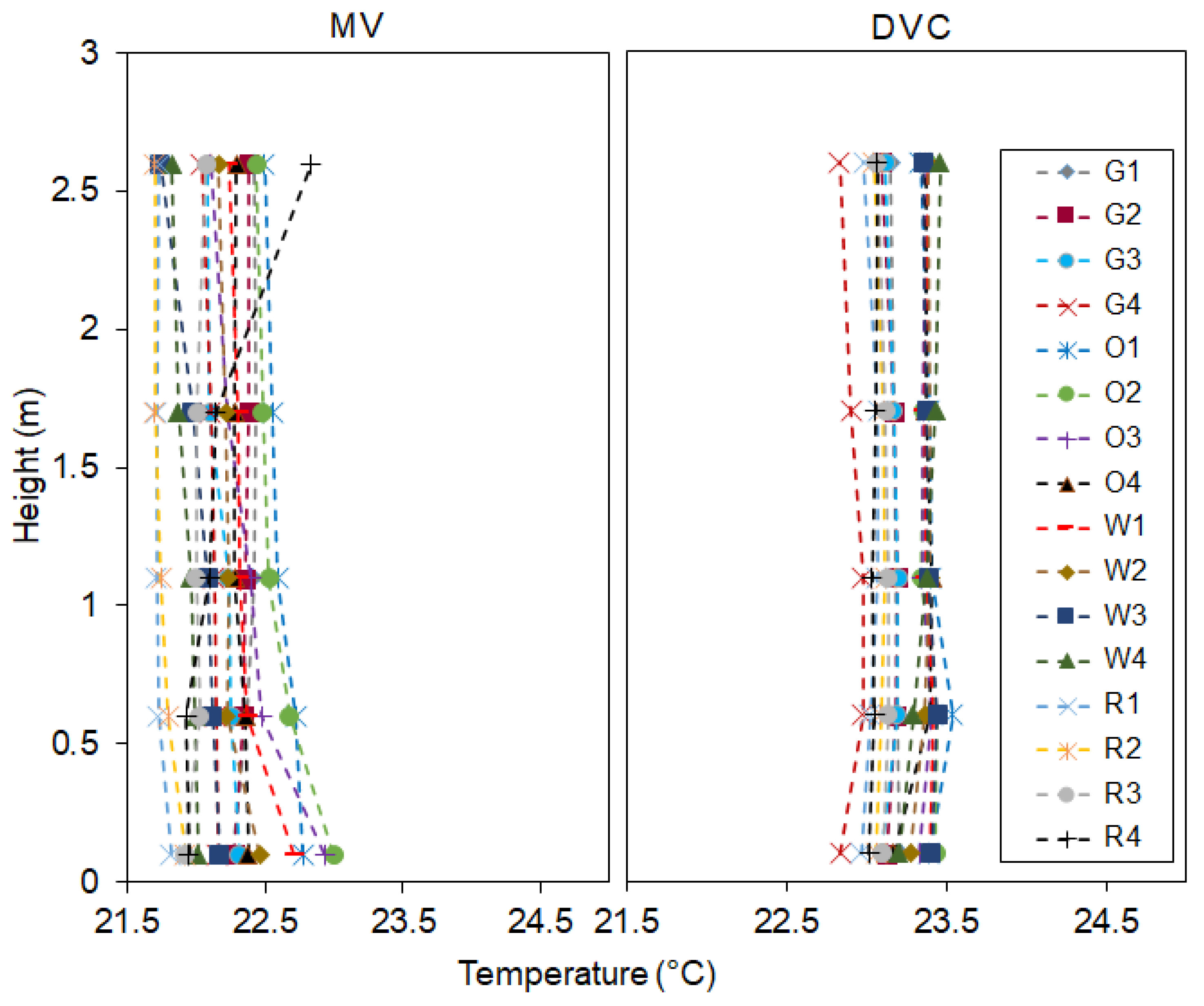
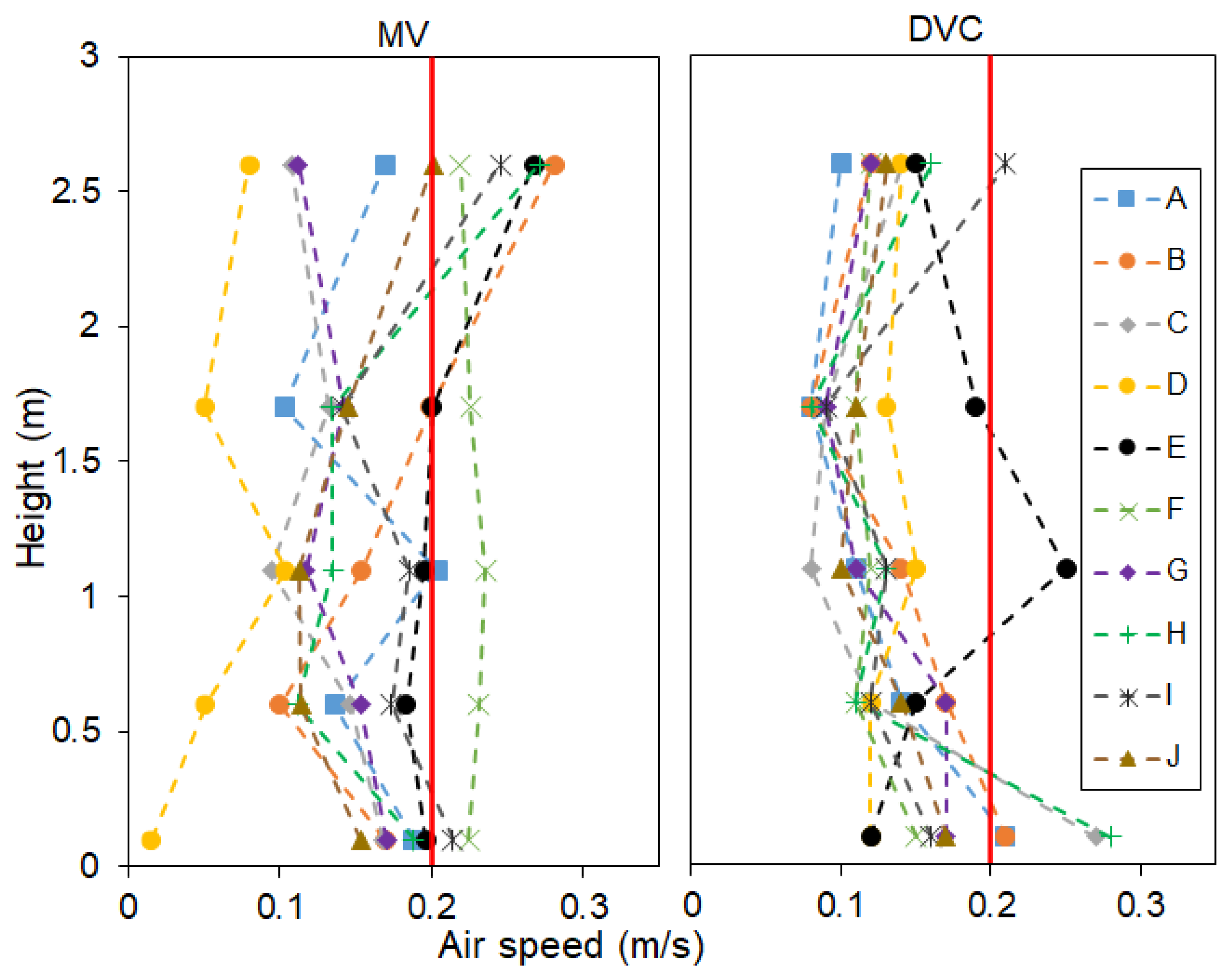
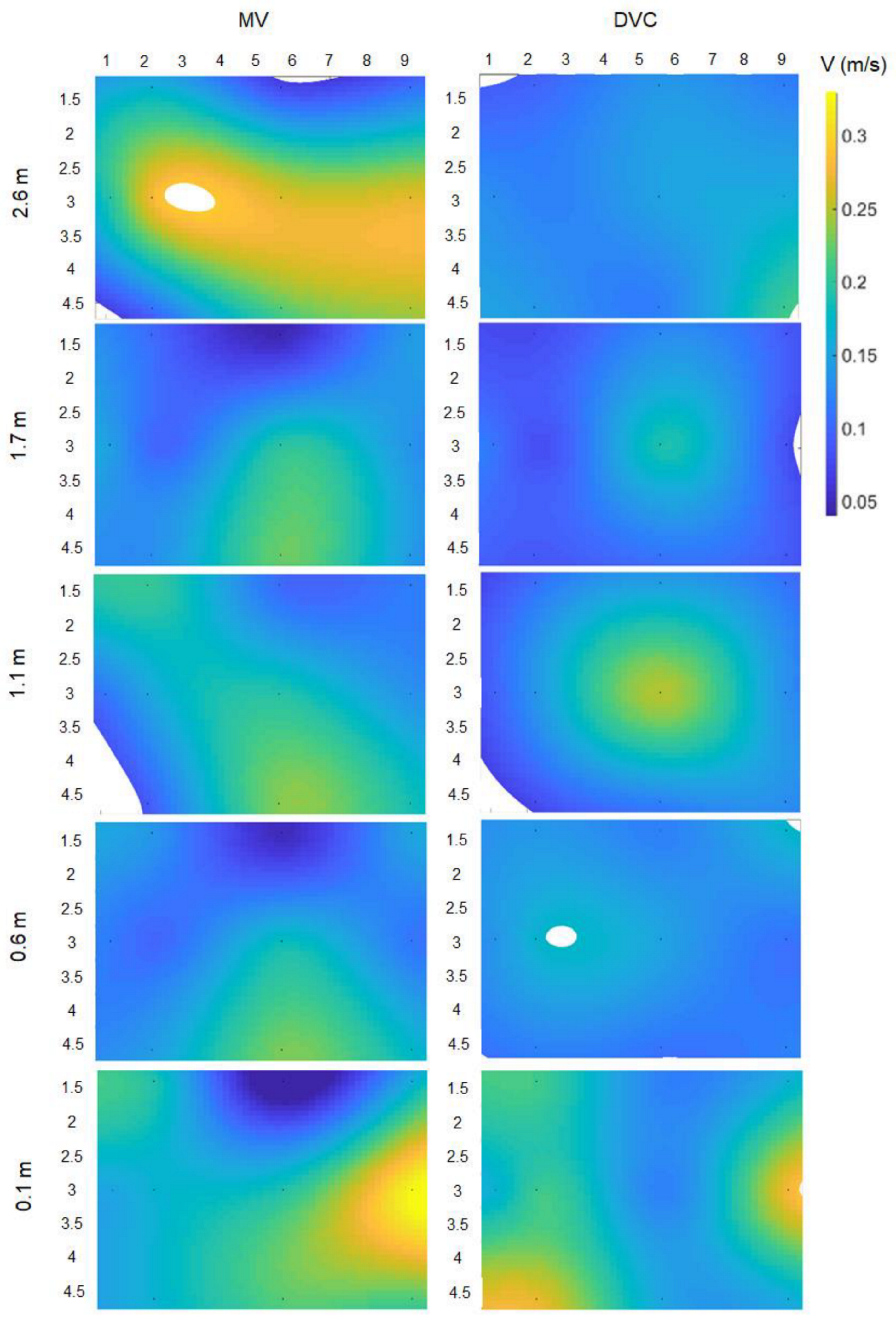

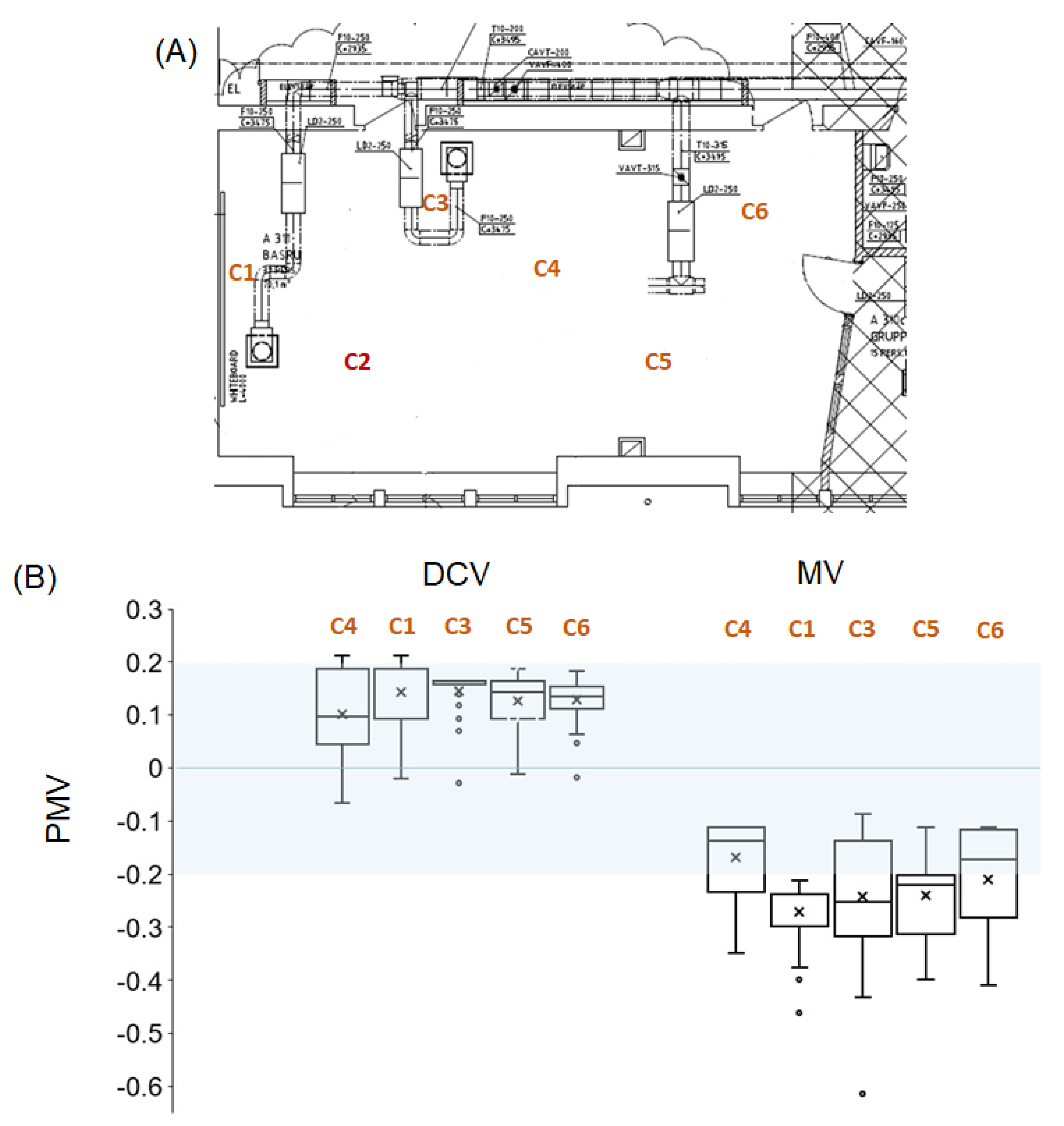
| Measurement Points | DCV | MV | ||
|---|---|---|---|---|
| Mean (°C) | SD | Mean (°C) | SD | |
| Supply | 18.1 | 0.03 | 18.3 | 0.03 |
| Exhaust 1 | 23.1 | 0.05 | 22.0 | 0.09 |
| Exhaust 2 | 22.6 | 0.06 | 21.9 | 0.06 |
| Room temperature | 23.0 | 0.08 | 22.2 | 0.07 |
| Surface—Corridor wall | 23.1 | 0.23 | 22.8 | 0.03 |
| Surface—Board wall | 23.6 | 0.01 | 22.7 | 0.04 |
| Surface—Window wall | 24.3 | 0.03 | 22.9 | 0.05 |
| Surface—Back wall | 24.0 | 0.02 | 22.8 | 0.03 |
| Surface—ceiling | 24.5 | 0.04 | 23.2 | 0.05 |
| Surface—floor | 24.0 | 0.03 | 22.7 | 0.04 |
| Plenum—Corridor wall | 20.9 | 0.02 | - | - |
| Plenum—Window wall | 20.0 | 0.02 | - | - |
| Plenum—Board wall | 20.1 | 0.03 | - | - |
| Plenum—Back wall | 19.2 | 0.02 | - | - |
| Ventilation | Local Air Change Index | Air Change Efficiency | |||||||
|---|---|---|---|---|---|---|---|---|---|
| A2 | A3 | A4 | A5 | B2 | B3 | B4 | B5 | ||
| MV | 1.09 | 1.07 | 0.99 | 0.95 | 1.02 | 1.00 | 0.97 | 1.03 | 53.85 |
| DCV | 1.07 | 1.08 | 1.03 | 1.07 | 1.05 | 1.03 | 1.05 | 1.04 | 48.60 |
| Ventilation | T20 (s) | C50 (dB) | G (dB) | Sound Pressure Level dB (A) (30) * | |
|---|---|---|---|---|---|
| 125 Hz (0.60) * | 250 to 4000 Hz (0.50) * | 250 to 4000 Hz (≥6) * | 250 to 4000 Hz (≤19) * | ||
| DCV | 0.72 | 0.65 | 5.1 | 17.6 | 30 |
| MV | 0.63 | 0.59 | 5.4 (≥6) | 18.2 | 33 |
Disclaimer/Publisher’s Note: The statements, opinions and data contained in all publications are solely those of the individual author(s) and contributor(s) and not of MDPI and/or the editor(s). MDPI and/or the editor(s) disclaim responsibility for any injury to people or property resulting from any ideas, methods, instructions or products referred to in the content. |
© 2023 by the authors. Licensee MDPI, Basel, Switzerland. This article is an open access article distributed under the terms and conditions of the Creative Commons Attribution (CC BY) license (https://creativecommons.org/licenses/by/4.0/).
Share and Cite
Ogbuagu, T.-C.C.; Linden, E.; MacCutcheon, D.; Nilsson, E.; Persson, T.; Kabanshi, A. On the Performance of Diffuse Ceiling Ventilation in Classrooms: A Pre-Occupancy Study at a School in Southern Sweden. Sustainability 2023, 15, 2546. https://doi.org/10.3390/su15032546
Ogbuagu T-CC, Linden E, MacCutcheon D, Nilsson E, Persson T, Kabanshi A. On the Performance of Diffuse Ceiling Ventilation in Classrooms: A Pre-Occupancy Study at a School in Southern Sweden. Sustainability. 2023; 15(3):2546. https://doi.org/10.3390/su15032546
Chicago/Turabian StyleOgbuagu, Too-Chukwu Cyracus, Elisabet Linden, Douglas MacCutcheon, Erling Nilsson, Torbjorn Persson, and Alan Kabanshi. 2023. "On the Performance of Diffuse Ceiling Ventilation in Classrooms: A Pre-Occupancy Study at a School in Southern Sweden" Sustainability 15, no. 3: 2546. https://doi.org/10.3390/su15032546
APA StyleOgbuagu, T.-C. C., Linden, E., MacCutcheon, D., Nilsson, E., Persson, T., & Kabanshi, A. (2023). On the Performance of Diffuse Ceiling Ventilation in Classrooms: A Pre-Occupancy Study at a School in Southern Sweden. Sustainability, 15(3), 2546. https://doi.org/10.3390/su15032546







